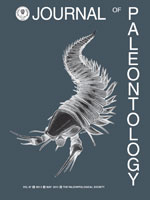Fine-grained sandstones and siltstones of Late Cretaceous to Eocene age in Antarctica and Tierra del Fuego yield an association of well-known shallow-marine trace fossils. Among them stick out complex spreite burrows, which are formally described as Euflabella n. igen. and subdivided into five ichnospecies with different burrowing programs and occurrences. As shown by concentrations of diatoms, radiolarians, foraminifers, and calcispheres in particular backfill lamellae, the unknown trace makers lived on fresh detritus from the surface as well as the burrowed sediment. In some ichnospecies, vertical sections show that the spreite is three-dimensionally meandering in upward direction and that upper laminae tend to rework the upper backfill of the folds underneath. This could mean a second harvest, after cultivated bacteria had time to ferment refractory sediment components, which the metazoan trace maker had been unable to digest before.
How to translate text using browser tools
1 May 2013
Euflabella N. Igen.: Complex Horizontal Spreite Burrows in Upper Cretaceous–Paleogene Shallow-Marine Sandstones of Antarctica and Tierra Del Fuego
Eduardo B. Olivero,
Maria I. López Cabrera
ACCESS THE FULL ARTICLE

Journal of Paleontology
Vol. 87 • No. 3
May 2013
Vol. 87 • No. 3
May 2013




